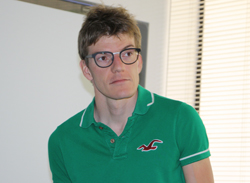Na tarde do dia 02 de fevereiro, o Dr. Jan  Baetens, do Department of Mathematical Modelling, Statistics and Bioinformatics da Ghent University (Bélgica), esteve no Instituto de Física de São Carlos (IFSC/USP), onde ministrou o seminário A behavioral analysis of cellular automata, no qual discutiu, em especial, o comportamento de um Autômato Celular.
Baetens, do Department of Mathematical Modelling, Statistics and Bioinformatics da Ghent University (Bélgica), esteve no Instituto de Física de São Carlos (IFSC/USP), onde ministrou o seminário A behavioral analysis of cellular automata, no qual discutiu, em especial, o comportamento de um Autômato Celular.
Atualmente, o Dr. Jan Baetens realiza seu pós-doutorado na já citada universidade, onde desenvolve pesquisas sobre Autômato Celular e modelos de paradigmas, a fim de modelar uma variedade de processos comumente estudados na área de ciências biológicas aplicadas. Saiba mais sobre o currículo do pesquisador, clicando AQUI.
Assessoria de Comunicação – IFSC/USP




 computers, cellular automata (CAs) became a full-fledged research domain in the eighties of the previous century. The relevant literature is of a dichotomous nature in the sense that studies either focus on the spatio-temporal dynamics that is evolved by CAs, while others merely use the CA paradigm to build a model for a given biological, natural or physical process. It goes without saying that a profound understanding of CA dynamics is a prerequisite for building realistic, identifiable CA-based models, though this is not straightforward due the fact that a CA is discrete in all its senses (state, time, space). In an attempt to quantify CA behavior in a meaningful and reproducible way, several so-called behavioral measures have been proposed during the last two decades. Here, we will show how Lyapunov exponents and Boolean derivatives can be used to get a complete picture of CA dynamics in the sense that they not only make it possible to unravel the nature of a given CA, but also allow for assessing the effect of changing model design parameters on the CA behavior, an understanding that is a prerequisite for CA-based models to become appreciated as a full-fledged modeling paradigm. Besides, it will be demonstrated that the scope of these measures is not limited to two-state CAs.
computers, cellular automata (CAs) became a full-fledged research domain in the eighties of the previous century. The relevant literature is of a dichotomous nature in the sense that studies either focus on the spatio-temporal dynamics that is evolved by CAs, while others merely use the CA paradigm to build a model for a given biological, natural or physical process. It goes without saying that a profound understanding of CA dynamics is a prerequisite for building realistic, identifiable CA-based models, though this is not straightforward due the fact that a CA is discrete in all its senses (state, time, space). In an attempt to quantify CA behavior in a meaningful and reproducible way, several so-called behavioral measures have been proposed during the last two decades. Here, we will show how Lyapunov exponents and Boolean derivatives can be used to get a complete picture of CA dynamics in the sense that they not only make it possible to unravel the nature of a given CA, but also allow for assessing the effect of changing model design parameters on the CA behavior, an understanding that is a prerequisite for CA-based models to become appreciated as a full-fledged modeling paradigm. Besides, it will be demonstrated that the scope of these measures is not limited to two-state CAs.